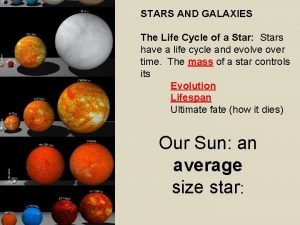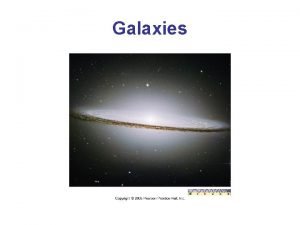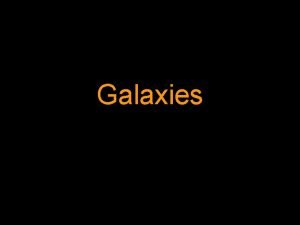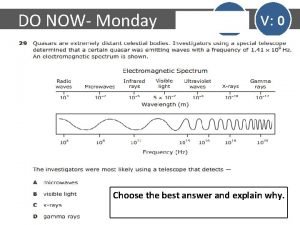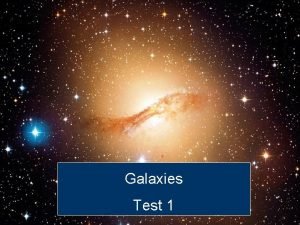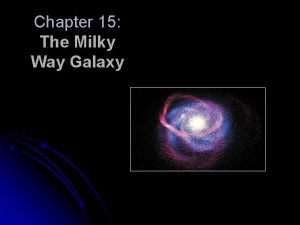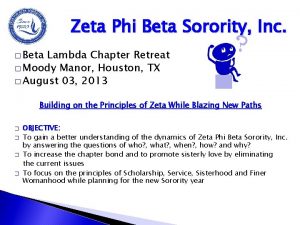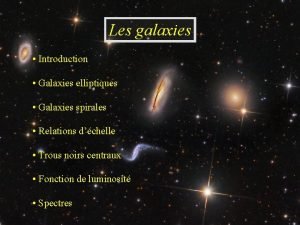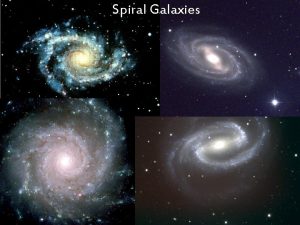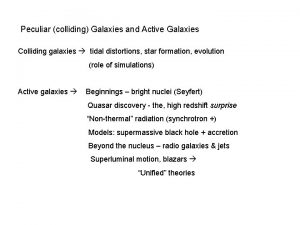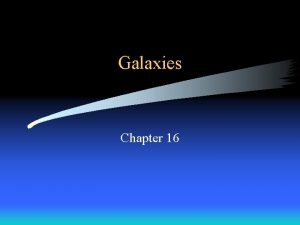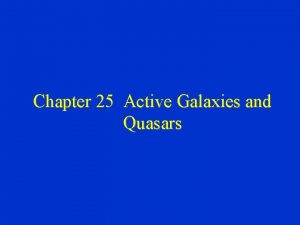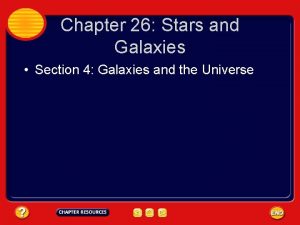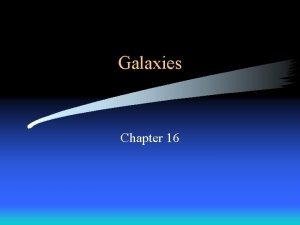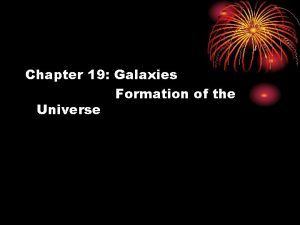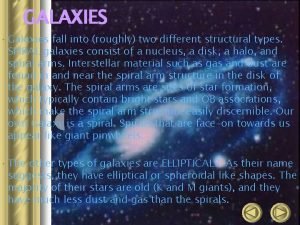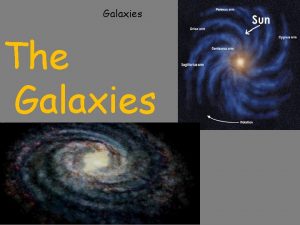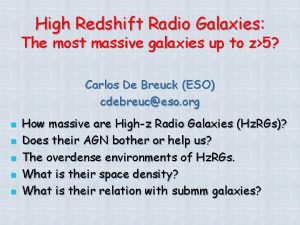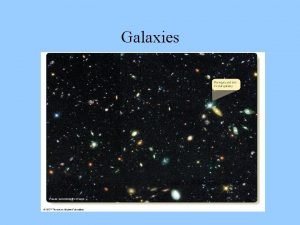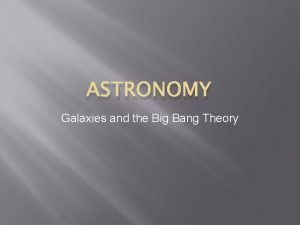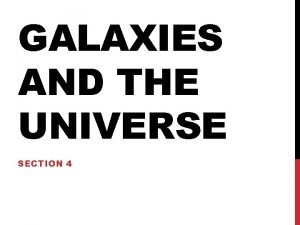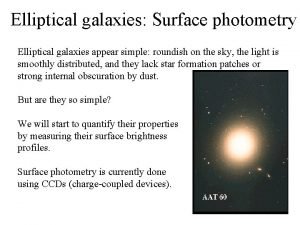Chapter 25 Galaxies What are galaxies How are



















































- Slides: 51

Chapter 25: Galaxies What are galaxies? How are they distributed in space? March 7, 2006 Astronomy 2010 1

Discovery of other Galaxies • Using large telescopes one can see clouds of dust and gas inside the Galaxy. • One can also see other peculiar milky nebulae scattered among the stars. • Some of these milky nebulae have spiral shapes • Others look like squashed spheres or tortured messes of material. • Three of the milky nebulae are visible as fuzzy patches to the naked eye: – one is in the constellation Andromeda – two others (called the Large and Small Magellanic Clouds after the first European explorer to see them, Ferdinand Magellan) are in the southern sky in the constellations Mensa and Hydrus. March 7, 2006 Astronomy 2010 2

Galaxies Discovery Pioneers • Work by – Edwin Hubble (lived 1889 --1953) – Milton Humason (lived 1891 --1972) – in the 1930's established that each of the spiral nebulae was another huge star system, called a galaxy • Galaxy is from the Greek ``galactos'', meaning ”milk”. • Hubble and Humason used large high resolution telescopes to measure the distances to the galaxies. March 7, 2006 Astronomy 2010 3

Other Galaxies • Galaxies are – organized systems – thousands to hundreds of thousands of light years across – made of tens of millions to trillions of stars – sometimes mixed with gas and dust all held together by their mutual gravity. March 7, 2006 Astronomy 2010 4

Star Count in a Galaxy – One gets an estimate of the number of stars in a galaxy by dividing the total luminosity of the galaxy by a typical star's luminosity. – A more accurate value would result if you use the galaxy's luminosity function (a table of the proportion of stars of a given luminosity). – Or you could divide the total mass of the galaxy by a typical star's mass (or use the mass function to get the proportions right). March 7, 2006 Astronomy 2010 5

Distances to other Galaxies • Distances between galaxies are large and are often measured in megaparsecs. • A megaparsec is one million parsecs – or about 3. 3 million light years. • Example: – distance between the Milky Way and the closest large galaxy, the Andromeda Galaxy, is about 0. 899 megaparsecs. March 7, 2006 Astronomy 2010 6

Shapley-Curtis debate – Big controversy in the 1910's and early 1920's over whether the nebulae called galaxies were outside the Milky Way or were part of it. – National Academy of Sciences held a debate between the opposing sides in 1920. – Those favoring a large Milky Way with the spiral nebulae inside it were represented by Harlow Shapley. – Those favoring the spiral nebulae as separate groups of stars outside the Milky Way were represented by Heber Curtis. – The Shapley-Curtis debate did not decide much beyond the fact that both sides had powerful evidence for their views. March 7, 2006 Astronomy 2010 7

Resolution • Edwin Hubble and Milton Humanson set out to resolve the debate – by using the largest telescope at the time, – the 100 -inch telescope on Mount Wilson, – to study the large spiral nebula in the Andromeda constellation. March 7, 2006 Astronomy 2010 8

Resolution (2) – Because of its large mirror, the telescope had sufficient resolving power and light-gathering power to spot individual stars in the Andromeda Galaxy. – In the mid-1920's they discovered Cepheid variables in the galaxy and used the period-luminosity relation to find that the distance to the galaxy was very much greater than even the largest estimates for the size of the Milky Way. – Galaxies are definitely outside the Milky Way and our galaxy is just one of billions of galaxies in the universe. – Their discovery continued the process started by Copernicus long ago of moving us from the center of the universe. March 7, 2006 Astronomy 2010 9

Types of Galaxies • Edwin Hubble divided the galaxies into three basic groups: – ellipticals, – spirals, – irregulars. March 7, 2006 Astronomy 2010 10

Types of Galaxies (2) – Ellipticals are smooth and round or elliptical. – Spirals are flat with a spiral pattern in their disk. – Irregulars have stars and gas in random patches. – Most galaxies are small and faint so only the luminous galaxies are seen at great distances. – Very luminous galaxies tend to be either the elliptical or spiral type, so they are the ones often displayed in astronomy textbooks. March 7, 2006 Astronomy 2010 11

Sequence of Galaxy Classification • Hubble (1936) put these groups onto a two -pronged sequence that looks like a tuning fork. • He thought (incorrectly) that galaxies evolved from left to right in diagram. March 7, 2006 Astronomy 2010 12

Not All Ideas are Correct… • Astronomers now know that it is NOT an evolutionary sequence because each type of galaxy has very old stars. • The oldest stars in any galaxy all have about the same age of around 15 billion years. • This means that spirals form as spirals, ellipticals form as ellipticals, and irregulars form as irregulars. • However, the “tuning fork” diagram remains convenient for classifying galaxies. March 7, 2006 Astronomy 2010 13

Ellipticals • Smooth and elliptical in appearance. • Have four distinguishing characteristics: – much more random star motion than orderly rotational motion • star orbits are aligned in a wide range of angles and have a wide range of eccentricities. – Little dust and gas left between the stars – No new star formation occurring now and no hot, bright, massive stars in them. – No spiral structure. March 7, 2006 Astronomy 2010 14

Elliptical Sub-classification • Most elliptical galaxies are small and faint. • The dwarf ellipticals may be the most common type of galaxy in the universe – (or maybe the dwarf irregulars are). • Examples of elliptical galaxies are M 32 (an E 2 dwarf elliptical next to the Andromeda Galaxy) and M 87 (a huge elliptical in the center of the Virgo cluster). March 7, 2006 Astronomy 2010 15

Elliptical Galaxies – Example 1 • Messier 32: a dwarf elliptical (E 2) satellite galaxy of the Andromeda Galaxy. March 7, 2006 Astronomy 2010 16

Elliptical Galaxies – Example 2 • Messier 87: – giant elliptical (E 1) – at the core of the Virgo Cluster – Grown very large by ``eating'' other galaxies. March 7, 2006 Astronomy 2010 17

Elliptical Galaxies – Example 3 • Leo I: – dwarf elliptical – E 3 – Local Group. March 7, 2006 Astronomy 2010 18

Elliptical Galaxies – Example 4 • Messier 110 – dwarf elliptical – E 6 – satellite of Andromeda Galaxy. March 7, 2006 Astronomy 2010 19

Spiral Galaxies • Flattened disks with a spiral pattern in the disk. • Spiral arms can go all of the way into the bulge or be attached to the ends of a long bar of gas and dust that bisects the bulge. March 7, 2006 Astronomy 2010 20

Spiral Galaxies Characteristics • Four distinguishing characteristics of the spirals are: 1. More orderly, rotational motion than random motion • the rotation refers to the disk as a whole and means that the star orbits are closely confined to a narrow range of angles and are fairly circular. 2. Lot of gas and dust between the stars. 3. New star formation occurring in the disk, particularly in the spiral arms. 4. A spiral structure. March 7, 2006 Astronomy 2010 21

Spiral Galaxies – Example 1 • Andromeda Galaxy – M 31 – large spiral galaxy (Sb) – near the Milky Way. – Note • M 32 just above it • M 110 below it. March 7, 2006 Astronomy 2010 22

Spiral Galaxies – Example 2 • Triangulum Galaxy • M 33 • Small spiral galaxy (Scd) • in the Local Group. March 7, 2006 Astronomy 2010 23

Spiral Galaxies – Example 3 • Messier 81 • Large spiral galaxy (Sb). March 7, 2006 Astronomy 2010 24

Spiral Galaxies – Example 4 • NGC 2997 • Large face-on spiral galaxy (Sc). March 7, 2006 Astronomy 2010 25

Spiral Galaxies – Example 5 • NGC 1365 – barred spiral galaxy (SBbc). March 7, 2006 Astronomy 2010 26

Spiral Galaxies – Example 6 • NGC 3351 • (M 95) • Barred spiral galaxy (SBb). March 7, 2006 Astronomy 2010 27

Irregular Galaxies • Irregular galaxies have no definite structure. • Stars bunched up but the patches are randomly distributed throughout the galaxy. • Some irregulars have a lot of dust and gas so star formation is possible. • Some are undergoing a burst of star formation “now”, many H II regions are seen in them. • Others have very little star formation going on in them (even some of those with a lot of gas and dust still in them). March 7, 2006 Astronomy 2010 28

Irregular Galaxies (2) • Most irregulars are small and faint. • The dwarf irregulars may be the most common type of galaxy in the universe (or maybe the dwarf ellipticals are). • Dwarf galaxies far away are faint and hard to see. • Perhaps if the dwarf galaxies were brighter, E. Hubble would have arranged the galaxies in a different sequence instead of the two-pronged sequence. • Examples of irregular galaxies are the Large and Small Magellanic Clouds (two small irregulars that orbit the Milky Way). March 7, 2006 Astronomy 2010 29

Irregular Galaxies – Example 1 • Large Magellanic Cloud – Dwarf irregular satellite galaxy of the Milky Way. March 7, 2006 Astronomy 2010 30

Irregular Galaxies – Example 2 • Small Magellanic Cloud – Dwarf irregular satellite galaxy of the Milky Way. March 7, 2006 Astronomy 2010 31

Irregular Galaxies – Example 3 • NGC 6822 – Dwarf irregular galaxy in the Local Group. March 7, 2006 Astronomy 2010 32

Irregular Galaxies – Example 4 • IC 5152 – Dwarf irregular galaxy in the Local Group. March 7, 2006 Astronomy 2010 33

Irregular Galaxies – Example 5 • NGC 1313 – starburst galaxy – also called a barred spiral galaxy (SBc). March 7, 2006 Astronomy 2010 34

Irregular Galaxies – Example 6 • Messier 82 – starburst galaxy. March 7, 2006 Astronomy 2010 35

Distribution in the Sky • Galaxies are distributed fairly uniformly across the sky. • Approximately the same number of galaxies are seen in every direction March 7, 2006 Astronomy 2010 36

More about Galaxy Distributions • The distribution of galaxies is not perfectly smooth. • They clump together into loose groups. • Three-dimensional maps of the universe have revealed surprisingly large structures in the universe. • Galaxies like to group together and those groups, in turn, congregate together. March 7, 2006 Astronomy 2010 37

Distances To Galaxies • As for the determination of stellar properties, finding the distance to galaxies is essential for comparing the galaxies against each other. • In order to determine the luminosities and masses of the galaxies and the distribution of the mass inside the galaxies, one must know their distance from our own Galaxy. March 7, 2006 Astronomy 2010 38

Galaxy Distance Determination • Use the period-luminosity relation of Cepheid variable stars to derive the distance from the apparent brightness of the Cepheids. – Works only for the nearby galaxies. • For galaxies farther away, other standard candle techniques involving objects more luminous than Cepheids like supernova explosions or supergiant stars are used. – Luminosities are not as well known or uniform, – Greater uncertainty in the derived distances to the very distant galaxies. March 7, 2006 Astronomy 2010 39

Distance and Redshift • In 1914, Vesto Slipher (1870 --1963) announced results from spectra of over 40 spiral galaxies. • He found that over 90% of the spectra showed redshifts which meant that they were moving away from us. • Edwin Hubble and Milton Humason found distances to the spiral nebulae. • When Hubble plotted the redshift vs. the distance of the galaxies, he found a surprising relation: – more distant galaxies are moving faster away from us. March 7, 2006 Astronomy 2010 44

Hubble Law • Hubble and Humason announced their result in 1931: – the Galactic recession speed = H distance, – where H is a number now called the Hubble constant. • This relation is called the Hubble Law and the Hubble constant is the slope of the line. March 7, 2006 Astronomy 2010 45

Determination of the Hubble Constant • With distances measured in megaparsecs (Mpc) and the recession speed in kilometers/second (km/sec), the Hubble constant is between 60 and 70 km/sec/Mpc. • Value found by using the galaxies that have accurate distances measured (Cepheids, etc. ) and dividing their recession speeds by their distances. March 7, 2006 Astronomy 2010 46

Benefits of the Hubble Law • It is easy to find the recession speeds of galaxies from their redshifts. • The Hubble law provides an easy way to measure the distances to even the farthest galaxies from the (recession speed/H). • For example, if a galaxy has a redshift of 20, 000 km/sec and H is set to 70 km/sec/Mpc, then the galaxy's distance = (20, 000 km/sec)/(70 km/sec/Mpc) = 20, 000/70 × [(km/sec)/(km/sec)] Mpc = 286 megaparsecs. March 7, 2006 Astronomy 2010 47

The Center of the Universe ? • At first glance, – it looks like the Milky Way is at the center of the universe – it committed some galactic social blunder because all of the other galaxies are rushing away from it (there a few true galactic friends like the Andromeda galaxy that are approaching it). March 7, 2006 Astronomy 2010 48

Copernican principle • Hubble law shows that there is actually not a violation of the Copernican principle. • More distant galaxies move faster. • Galaxies (or galaxy clusters) are all moving away from each other • The universe is expanding uniformly. • Every other galaxy or galaxy cluster is moving away from everyone else. • Every galaxy would see the same Hubble law. March 7, 2006 Astronomy 2010 49

Expansion March 7, 2006 Astronomy 2010 50

March 7, 2006 Astronomy 2010 51

Masses of Galaxies • Masses of galaxies are found from the orbital motion of their stars. • Stars in a more massive galaxy orbit faster than those in a lower mass galaxy because the greater gravity force of the massive galaxy causes larger accelerations of its stars. • By measuring the star speeds, one finds out how much gravity there is in the galaxy. • Since gravity depends on mass and distance, knowing the size of the star orbits enables you to derive the galaxy's mass. March 7, 2006 Astronomy 2010 52

Masses from Rotation Curve for Spiral Galaxies • The rotation curve shows how orbital speeds in a galaxy depend on their distance from the galaxy's center. • The mass inside a given distance from the center = (orbital speed)2 × (distance from the center)/G. • Obital speed is found from the doppler shifts of the 21 -cm line radiation from the atomic hydrogen gas. March 7, 2006 Astronomy 2010 53

A Mass Problem • The stars and gas in most galaxies move much quicker than expected from the luminosity of the galaxies. • In spiral galaxies, the rotation curve remains at about the same value at great distances from the center (it is said to be “flat”). • This means that the enclosed mass continues to increase even though the amount of visible, luminous matter falls off at large distances from the center. • In elliptical galaxies, the gravity of the visible matter is not strong enough to accelerate the stars as much as they are. • Something else must be adding to the gravity of the galaxies without shining. March 7, 2006 Astronomy 2010 54

Dark Matter Problem • That something else is called dark matter. • It is material that does not produce detectable amounts of light but it does have a noticeable gravitational effect. • Astronomers are not sure what the dark matter is made of. • Possibilities range from large things like planets, brown dwarfs, white dwarfs, black holes to huge numbers of small things like neutrinos or other particles that have not been seen in our laboratories yet. • The nature of dark matter is one of the central problems in astronomy today. March 7, 2006 Astronomy 2010 55
 Antigentest åre
Antigentest åre Chapter 30 galaxies and the universe
Chapter 30 galaxies and the universe Waves produced by stars and galaxies
Waves produced by stars and galaxies Life cycle of galaxies
Life cycle of galaxies Elliptical galaxies facts
Elliptical galaxies facts Th eirregulars
Th eirregulars Era of galaxies
Era of galaxies Critical density
Critical density What are galaxies
What are galaxies Brainpop galaxies quiz answers
Brainpop galaxies quiz answers 4 types of galaxies
4 types of galaxies How are galaxies classified? *
How are galaxies classified? * Galaxie s
Galaxie s Tipus de galaxies
Tipus de galaxies Properties of elliptical galaxies
Properties of elliptical galaxies Evolution of galaxies
Evolution of galaxies Universepg
Universepg Galaxies lesson plan
Galaxies lesson plan The red tent book summary
The red tent book summary Summary of chapter 8 the great gatsby
Summary of chapter 8 the great gatsby Chapter 10 chemical reactions answer key
Chapter 10 chemical reactions answer key Chapter 11 study guide chemistry stoichiometry answer key
Chapter 11 study guide chemistry stoichiometry answer key Chapter 9 chemical reactions study guide
Chapter 9 chemical reactions study guide Similarity ratio definition
Similarity ratio definition Chapter 6: career readiness
Chapter 6: career readiness Chapter 7 ionic and metallic bonding chapter answer key
Chapter 7 ionic and metallic bonding chapter answer key Chapter 9 surface water chapter assessment answer key
Chapter 9 surface water chapter assessment answer key Chapter 2 physics test prep representing motion
Chapter 2 physics test prep representing motion Chemistry: the central science chapter 14 answers
Chemistry: the central science chapter 14 answers Chapter 7 ionic and metallic bonding answer key
Chapter 7 ionic and metallic bonding answer key Chapter 4 section 1 population dynamics answer key
Chapter 4 section 1 population dynamics answer key Chapter 2 standardized test practice answers
Chapter 2 standardized test practice answers Book of philippians background
Book of philippians background Ionic compounds properties
Ionic compounds properties Chemistry chapter 7 ionic and metallic bonding
Chemistry chapter 7 ionic and metallic bonding 9 chemical names and formulas
9 chemical names and formulas Zeta phi beta closing prayer
Zeta phi beta closing prayer Working with young children chapter 1
Working with young children chapter 1 Wuthering heights chapter 10 summary
Wuthering heights chapter 10 summary Wuthering heights chapter 6 summary
Wuthering heights chapter 6 summary Qualitative paper example
Qualitative paper example Chapter 24 world war looms
Chapter 24 world war looms Chapter 16 building vocabulary world war looms
Chapter 16 building vocabulary world war looms Chapter 27 world war 1 and the russian revolution
Chapter 27 world war 1 and the russian revolution Chapter 27 lesson 4 world war 1 ends
Chapter 27 lesson 4 world war 1 ends Chapter 17 section 3 luther leads the reformation
Chapter 17 section 3 luther leads the reformation Chapter 32 assessment world history
Chapter 32 assessment world history Chapter 30 section 2 world history
Chapter 30 section 2 world history Chapter 8 nationalist revolutions sweep the west
Chapter 8 nationalist revolutions sweep the west What was the counter-reformation?
What was the counter-reformation? Chapter 10 section 2 central america and the caribbean
Chapter 10 section 2 central america and the caribbean Ap human geography chapter 11 vocab
Ap human geography chapter 11 vocab



